CyberKnife Surgery: Innovative Cancer Treatment
The CyberKnife system is a non-invasive and painless alternative to surgery in treating oncology. Radiation harmful to malignant cells is directed precisely at the tumor without damaging healthy tissues.
Today, this method gives hope to people with inoperable and hard-to-reach tumors. It is also an alternative for those who want to avoid surgical treatment and severe complications of chemotherapy and traditional radiation therapy.
What is a CyberKnife?
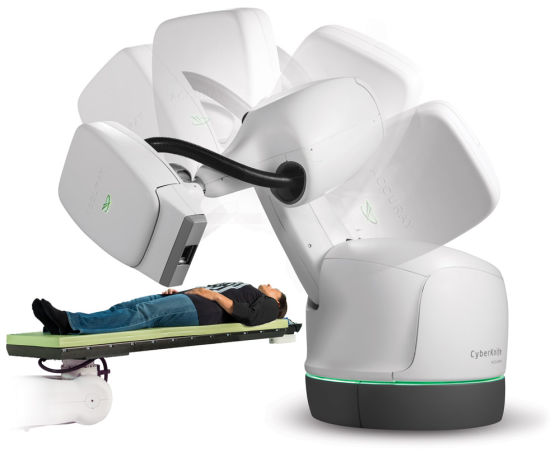 For radiosurgical operations, doctors use narrow beams of powerful ionizing radiation created by specialized devices. Due to the functional similarity with a traditional scalpel, devices for radiosurgery are called "knives."
For radiosurgical operations, doctors use narrow beams of powerful ionizing radiation created by specialized devices. Due to the functional similarity with a traditional scalpel, devices for radiosurgery are called "knives."
The first CyberKnife was developed in 1992. Its creator was the American professor John Adler, who previously taught at Stanford University.
What is a CyberKnife Treatment? The system consists of a device emitting a radiation beam, a "blade" of the CyberKnife, and a robotic installation. There are no restrictions on breathing and body position for the patient. If he moves a little, the mechanical "hand" corrects the emitter's position. It is one of the advantages of CyberKnife over the Gamma Knife, called the "gold standard" of radiosurgery.
When is a CyberKnife used?
The unique CyberKnife system can treat complex tumors in almost any body part: brain, head, neck, spine, chest, lungs, liver, pancreas, kidneys, pelvis, prostate, etc. The CyberKnife cancer treatment allows doctors to avoid skull trepanation. It improves the patient's quality of life.
This technique has traditionally been used to fight tumors from 3 to 6 cm, but the technology is constantly improving. Recent studies have shown the effectiveness of CyberKnife with larger neoplasms.
The CyberKnife cancer treatment can remove primary tumors and combat metastasis.
CyberKnife Surgery step-by-step
 It takes several days for preparation and planning. How long and many sessions there are depends on the tumor type, where it is, and how the patient feels. The course of CyberKnife therapy is usually 1-5 sessions. On average, the session lasts from 40 minutes to an hour.
It takes several days for preparation and planning. How long and many sessions there are depends on the tumor type, where it is, and how the patient feels. The course of CyberKnife therapy is usually 1-5 sessions. On average, the session lasts from 40 minutes to an hour.
The CyberKnife device is only designed to consider the movements of the patient and the tumor, even during treatment. The patient can change the position of the body and move his head. In addition, CyberKnife provides a minimal radiation field, minimizing the impact on healthy tissues.
During treatment, a robotic arm moves around the patient's head or body, directing thin radiation beams from various positions into the tumor.
During the tumor irradiation, there is no pain or other sensations. Therefore, hospitalization and rehabilitation are not required without complications, and the patient can immediately return to daily life.
The method's scope is constantly expanding, and at the same time, it has several limitations. Therefore, individual consultation with specialists is necessary in each case to decide on the possibility of treating CyberKnife or alternative technology.
What are the advantages?
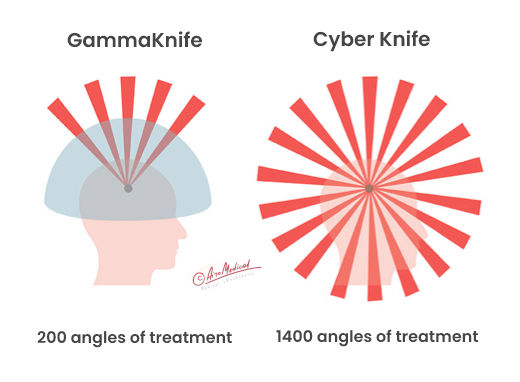 The CyberKnife can determine the exact position of the patient and the tumor without using special devices to attach the head or body position.
The CyberKnife can determine the exact position of the patient and the tumor without using special devices to attach the head or body position.
The benefits of the CyberKnife:
- A bloodless, painless alternative to surgical treatment of tumors in any part of the body.
- Outpatient treatment.
- The ability to remove inoperable tumors.
- Fewer complications and side effects compared to traditional surgery.
- Patient comfort during therapy, without anesthesia or rigid fixation.
- Shorter treatment time: usually, it takes from 1 to 5 procedures with an interval of one day.
- Does not require rehabilitation.
Patients who have been treated with CyberKnife talk about minimal side effects. In addition, in most cases, patients can return to daily life immediately after the therapy.
How about disadvantages?
CyberKnife radiation therapy has several disadvantages. The effect of the treatment does not manifest itself immediately. The patient can observe the first signs of positive changes 2-3 months after irradiation. Tumors stop growing and gradually disappear. At the same time, for some tumors, recovery takes longer.
The second significant disadvantage is that CyberKnife cannot eliminate some types of malignant neoplasms. These include tumors exceeding the maximum equipment limit (6x6 cm).
CyberKnife side effects
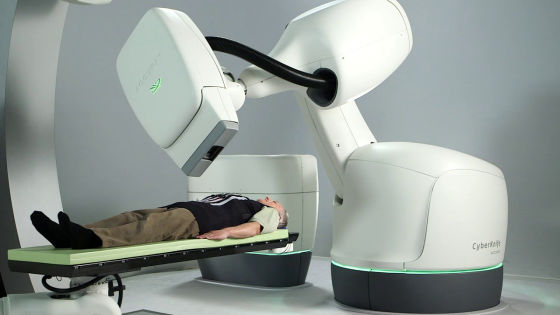 Compared to traditional radiation therapy, the risk of side effects and complications is much lower. Usually, they are different for each person. CyberKnife cancer treatment can sometimes cause mild side effects like fatigue, nausea, headaches, and vomiting, but this is the exception, not the rule. These problems don't last long and go away one to two weeks after treatment.
Compared to traditional radiation therapy, the risk of side effects and complications is much lower. Usually, they are different for each person. CyberKnife cancer treatment can sometimes cause mild side effects like fatigue, nausea, headaches, and vomiting, but this is the exception, not the rule. These problems don't last long and go away one to two weeks after treatment.
The vast majority of patients experience only minimal and short-term side effects.
Very rarely, there is redness of the skin or a slowdown in hair growth over the affected area. It is caused by the radiation emitted by the device focused on the lesion. It is too small to damage the epidermis or hair follicles.
Possible side effects are discussed already at the initial consultation. Potential risks are assessed case-by-case basis, as they depend on the tumor's location and the treatment duration.
CyberKnife Treatment in Oncology
Prostate Cancer
CyberKnife radiation is a good treatment option for prostate cancer. Cyberknife is commonly used for patients:
- at an early stage of the disease;
- when the tumor has not gone beyond the prostate gland;
- with cancer that is not amenable to surgical treatment or other methods of radiation therapy.
If the prostate gland is enlarged, the patient first undergoes hormone therapy. After reducing the gland size, a Cyberknife is used. CyberKnife cancer treatment is not used in patients with a high risk of lymph node tumors.
Pancreatic Cancer
CyberKnife has been clinically proven to treat pancreatic cancer effectively. Oncologists can use it in several ways:
- before surgery to give a better chance of success of the operation;
- instead of surgery;
- after surgery to treat any remaining microscopic cells;
- in combination with chemotherapy.
CyberKnife cancer treatment is advisable when the tumor is detected in the head of the pancreas. However, traditional surgery is still the priority when the cancer is localized in the tail of the organ's body.
Oncologists, radiologists, and neurosurgeons resort to CyberKnife cancer treatment when patients prefer not to be exposed to the risks and consequences of surgery.
Breast Cancer
CyberKnife offers a safer and faster way to treat non-metastatic breast cancer or cancer that has not spread beyond the breast. In some cases, using CyberKnife prevents a mastectomy. In other instances, CyberKnife cancer treatment may be combined with chemotherapy or surgery.
The therapy has less radiation exposure to surrounding tissues, including the heart and lungs, reducing the risk of damage to these vital organs. In addition, the course of treatment takes up to five sessions in a few days.
Lung Cancer
With operable cancer at an early stage, surgical removal is usually considered the standard of treatment, with a cure rate of up to 70%. However, suppose the patient's ability to tolerate surgery is in question due to concomitant diseases. In that case, doctors may offer him radiation therapy.
CyberKnife cancer treatment is a powerful and accurate radiotherapy method. It is suitable for patients with primary or recurrent lung cancer or lung metastases from cancer from other body parts.
CyberKnife radiosurgery allows doctors to irradiate several foci in both lungs while maintaining the respiratory ability of the lungs, preventing relapse.
Ovarian Cancer
About 80% of patients with cancer of the fallopian tubes and ovaries experience cancer recurrence after the first course of chemotherapy. As a result, they need additional therapy, and some may benefit from the CyberKnife cancer treatment. It is effective in combination with chemotherapy and immune and proton therapy.
CyberKnife Cancer Treatment in Germany
The AiroMedical team aims to provide an individual approach to the patient in diagnosis and modern treatment that can ensure recovery. With CyberKnife, we achieve these goals. AiroMedical's long-term experience has shown that the CyberKnife cancer treatment in Germany has several advantages:
- High-precision diagnostics. The latest research methods help to indicate the tumor's exact location and detect metastases if any. In addition, metastases can be removed using CyberKnife, which prolongs and improves patients' quality of life.
- Modern devices. Equipment is constantly being updated in German clinics. CyberKnife installations work for only a few years, then change to new, improved ones.
- Сombination with other techniques. All areas of oncology are well-developed in Germany. Here, difficult-to-localize tumors are treated not only by radiosurgical methods. The latest high-tech surgical operations, chemotherapy, immunotherapy, and targeted therapy are also used. The combination of several ways, including CyberKnife, achieves better treatment results.
CyberKnife is considered a more advanced technology for treating tumors than Gamma knife. Therefore, only in some hospitals where the CyberKnife is used. However, several medical centers in Germany use this method of radiosurgical exposure.
German centers for CyberKnife radiation
University Hospital Charite Berlin
 According to Focus magazine, the Department of radiation oncology and radiation therapy the clinic is among the best medical institutions in Germany in its specialization.
According to Focus magazine, the Department of radiation oncology and radiation therapy the clinic is among the best medical institutions in Germany in its specialization.
The Department successfully uses the advanced CyberKnife radiosurgical system in its clinical practice. The clinical CyberKnife system reduces small and large tumors of almost any localization, including tumors of the brain, head, neck, spine, chest, lungs, liver, pancreas, kidneys, and prostate, making it unique and incredibly effective in the fight against cancer.
The medical team also specializes in such modern types of radiation as visual controlled radiation therapy (IGRT), intensity modulated radiation therapy (IMRT), volume modulated arc therapy (VMAT), intraoperative radiation therapy, tomotherapy, and others.
All types of radiation therapy are highly effective. They allow doctors to focus the maximum radiation dose on the pathological area without damaging healthy tissues. During treatment, the doctors of the department strictly follow the current clinical protocols and comply with radiation protection standards, which minimizes complications and risks for the patient.
Helios Hospital Berlin-Buch
 The Department of radiation therapy, radiation Oncology at the hospital specializes in modern Cyberknife treatment to eliminate cancer and pain syndromes. Radiation therapy can be performed before, during, or after surgery. In some cases, radiation therapy gives a positive result. And there is no need for surgical treatment. The doctors of the department are highly professional specialists. They have a unique experience thanks to their excellent medical services.
The Department of radiation therapy, radiation Oncology at the hospital specializes in modern Cyberknife treatment to eliminate cancer and pain syndromes. Radiation therapy can be performed before, during, or after surgery. In some cases, radiation therapy gives a positive result. And there is no need for surgical treatment. The doctors of the department are highly professional specialists. They have a unique experience thanks to their excellent medical services.
Northwest Hospital Frankfurt-am-Main
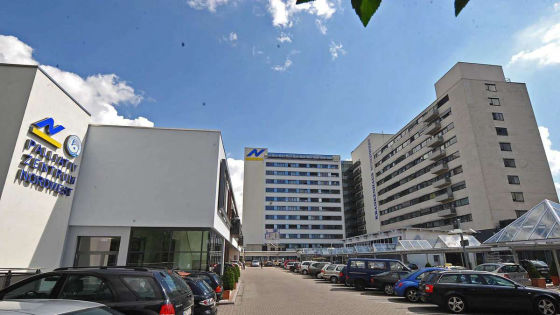 The CyberKnife procedure is performed in the radiotherapy department. Specialists in radiation therapy carry out the process. The accuracy of the course is 0.5 mm. Healthy tissues are not affected.
The CyberKnife procedure is performed in the radiotherapy department. Specialists in radiation therapy carry out the process. The accuracy of the course is 0.5 mm. Healthy tissues are not affected.
Doctors perform the procedure on an outpatient basis.CyberKnife cancer treatment is painless, and the patient is conscious. After the procedure, a person can return home.
European Radiosurgery Centre Munich
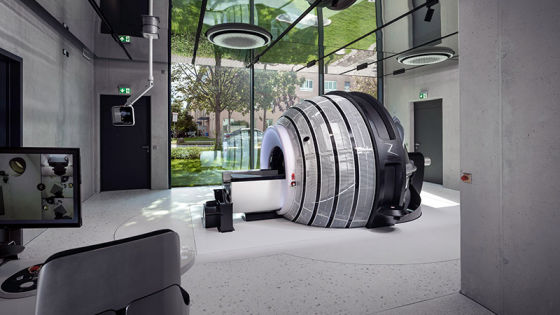 CyberKnife Center in Munich is among the best medical institutions in Europe for the radiosurgical treatment of benign and malignant tumors. Over the years, the Radiosurgery Center has performed more than 11,000 CyberKnife operations, including for foreign patients — this is the most significant number of operations in Europe among similar medical centers.
CyberKnife Center in Munich is among the best medical institutions in Europe for the radiosurgical treatment of benign and malignant tumors. Over the years, the Radiosurgery Center has performed more than 11,000 CyberKnife operations, including for foreign patients — this is the most significant number of operations in Europe among similar medical centers.
CyberKnife cancer treatment has a success rate of up to 95%. As a result, it occupies a leading position compared to other methods of fighting cancer.
CyberKnife Destinations. Where to travel?
How to start CyberKnife Cancer treatment?
You can get information about various options for diagnosis and oncology treatment in European clinics and help organize a trip for examination by leaving a request on our website.
The company AiroMedical organizes treatment in the best clinics in Germany and beyond, which have a CyberKnife system at their disposal. It allows them to fight malignant tumors with a high chance of successful recovery.
Please send us the medical documentation:
- An AiroMedical doctor will examine them.
- Our medical experts will contact the best foreign doctors to find all the features for treating your disease. Based on your medical reports, German doctors will be able to recommend therapy options, as well as inform the cost of treatment and diagnostic programs.
- We will take care of all the organizational issues of the trip.
The quality and effectiveness of CyberKnife cancer treatment, clinics equipped with the latest technology, and highly qualified doctors allow patients to get the best effect from therapy.
References:
- National Library of Medicine: Analysis of clinical efficacy of CyberKnife
- BMC Cancer: Clinical outcomes and prognostic factors
- NeuroNews: Accuray announces two decades of clinical data on CyberKnife robotic radiotherapy platform
- Medicine: Comparison of survival outcomes after CyberKnife radiotherapy